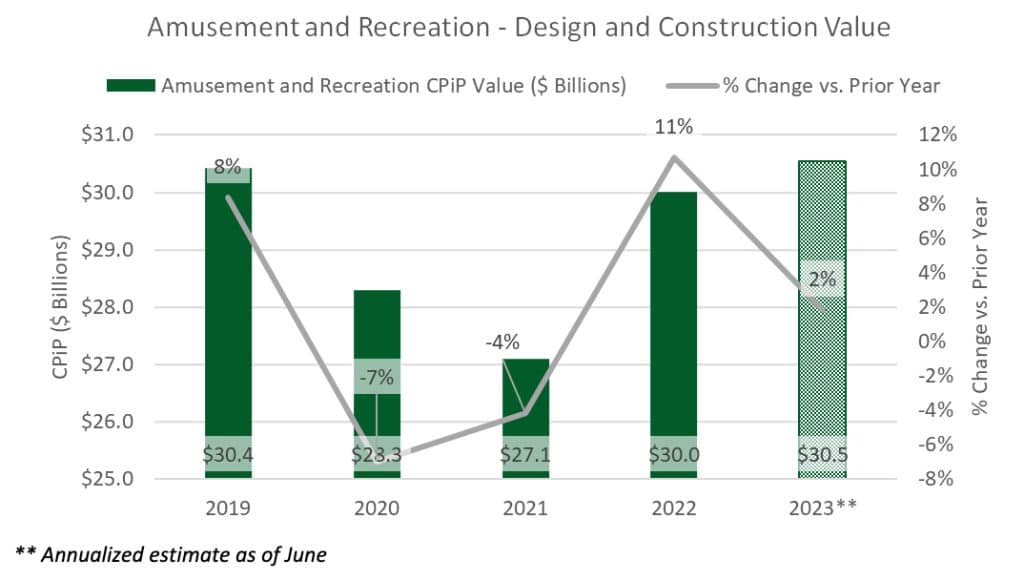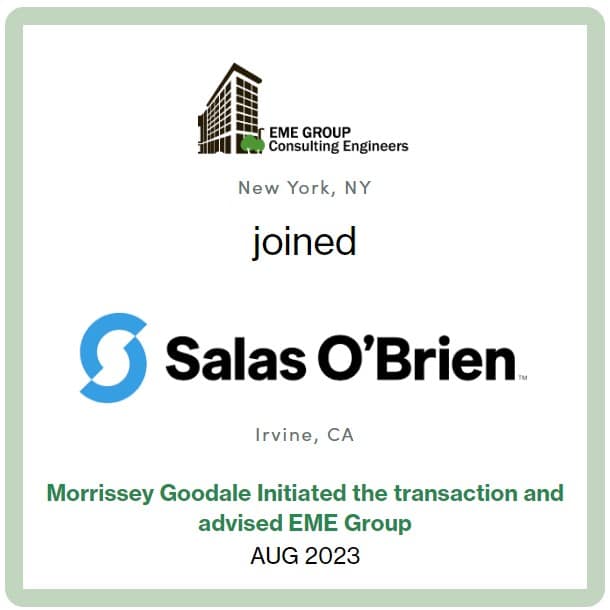Word on the street > The Ultimate AE and Environmental Industry Playlist; Take Control and Keep Your Rising Stars
Word on the Street: Issue 163
Weekly real-time market and industry intelligence from Morrissey Goodale firm leaders.

The Ultimate AE and Environmental Industry Playlist
We’d like to say a massive “thank you” to all our readers from around the world who selected the over 200 songs for our Ultimate AE and Environmental Industry Playlist.
We originally intended for the playlist to celebrate the industry by featuring songs about how planners, designers, surveyors, and scientists shape, measure, impact, enhance, and protect the built and natural environment. We also envisioned songs that referenced the profession in their titles or lyrics. However, y’all took it one step further and added a wealth of music about doing business as a design or environmental firm. So again, thank you!
You can find the complete playlist here (Spotify) or here (Apple Music). (Note the Apple Music version has the original artist versions of “Big Yellow Taxi” and “Powderfinger”among others). And for those who asked, the top 10 most suggested songs were as follows:
- We Built This City – Starship
- Takin’ Care of Business – Bachman-Turner Overdrive
- Truckin’ – Grateful Dead
- Hotel California – Eagles
- Landslide – Fleetwood Mac
- Highway to Hell – AC/DC
- Have You Ever Seen the Rain? – Creedence Clearwater Revival
- Don’t Stop Believin’ – Journey
- Working on the Highway – Bruce Springsteen
- Jet Airliner – Steve Miller Band
The playlist will provide the soundtrack for the 200-plus industry executives and investors during the networking receptions and intermissions at our upcoming Texas and Southern States M&A, Strategy, and Innovation Symposium in Houston this October.
Coda: I’m thinking of compiling a list of (non-documentary) movies in which great architectural or engineering designs or environmental works are critical plot elements (Can you say Chinatown?) or where an architect or engineer or surveyor or environmental consultant is among the key characters (Inception). If you have suggestions, contact me at [email protected] or 508.380.1868.
Take Control and Keep Your Rising Stars
If you took a psychology course or two in college or elsewhere, you may have learned about Julian Rotter, a psychologist who developed the concept of internal and external locus of control. Locus of control describes the extent to which people believe they can control things in their lives, including decisions, events, and outcomes.
As you might have already surmised, individuals with an internal locus of control believe that they exercise a great deal of control over their own lives, actions, and eventual consequences. They attribute their successes and failures to their own efforts, decisions, and abilities, and tend to be accountable folks.
Those who assume an external locus of control, on the other hand, are inclined to believe that luck, fate, chance, or the actions of others largely determine their destiny. They feel that they have relatively little control over what happens to them and regardless of what they do, their fate is largely determined by external factors.
Now, even if you have the strongest internal locus of control, sometimes there simply isn’t anything you can do about the departure of rising stars—whether their spouse landed a fantastic out-of-state job, a family member of theirs fell ill, or they finally decided to make a major career change.
But there are many more situations in which you can have at least some influence over whether rising stars leave or stay, such as when they:
- Feel stuck, unable to rise in the organization, or overlooked for ownership
- Feel disrespected personally and professionally, or unappreciated and taken for granted
- Feel repeatedly passed over for advancement or recognition
- Think the firm doesn’t have the greater good in mind
These are problems you can solve (or at least mitigate) if you take responsibility for them—and you don’t let them fester.
To keep your rising stars from seeking higher ground with your toughest competitors, you’ll have to address various aspects of your firm’s work environment, culture, and employee welfare. Here’s how:
1. Establish a meaningful vision and a strategic plan for achieving it. Your rising stars want to be confident that their company is going somewhere worthwhile, and they want to take that ride with you. A vivid, compelling vision of the future along with a strategic roadmap for getting there goes a long way in giving rising stars a clear sense of purpose and direction. It helps them understand how their individual roles and contributions fit into the larger picture, sparks enthusiasm and dedication, and encourages them to go above and beyond their basic responsibilities to contribute to the firm’s growth and success.
2. Make responsible autonomy the bedrock of your firm’s culture. AE firms employ highly skilled and specialized professionals who possess in-depth knowledge and expertise in their fields. So, trust that they will use their autonomy responsibly. That doesn’t mean completely turning your back on them and hoping for the best. Instead, be clear about expectations in terms of responsibilities and outcomes, and encourage them to take initiative within that scope. In other words, give your rising stars direction, not directions.
3. Coach the coaches. Ensure that your firm’s leaders and managers are skilled “people developers.” Provide them with training and coaching to help them improve their ability to communicate (practice listening, in particular), coach (learn how to help rising stars get “unstuck”), and deliver feedback (understand the importance of giving negative assessments, among other lessons) to your firm’s rising stars.
4. Get out of your comfort zone and delegate. Your firm most likely cares about quality, and that may lead some of your more experienced managers to think twice about delegating, particularly if they don’t believe the younger professionals are fully competent, whether due to inexperience or a lack of drive or intellectual curiosity (real or perceived). But delegation needs to happen if the developing stars in your firm are going to learn, grow, and stick around. Eventually, the protégé may deliver even better than the mentor, and this potential reality slap may be yet another conscious or unconscious inhibitor to delegation. In any event, delegation is necessary for the development of the rising stars who are likely to become your firm’s leaders someday.
5. Loosen your death-grip on company information. The good, the bad, and the ugly—share it all with your rising stars. Keeping them in the loop is a sign of respect. All too often, I’ve seen instances where rising stars are on a need-to-know basis—leadership figures they don’t need to know, so out the door they go. Rising stars want and need to understand how their firm is performing. Consider it training. If you expect them to lead your firm in the future, teach them how to read the gauges now.
6. Remove the B.S. from your firm’s career path program. I’ve seen a lot of placating in this area of human resources management. Well-intentioned people want to make sure no employee is left behind, so they create “dual career paths” for managers and technical staff. And before you know it, you are knee-deep in nebulous titles and vague responsibilities. The technical track ends up as a parking lot for those who can’t or won’t sell or lead. The real problem comes when your rising stars get stuck in this maze and see no other way up than out. Instead, establish clear succession plans for those who are vacating key roles in the organization, and begin preparing the rising stars who will be taking on their responsibilities.
7. Pay rising stars what they’re worth. It only makes sense that rising stars should earn more than employees who make lesser contributions to your firm’s success. Your rising stars are the ones being recruited and the ones with options. Paying them more than their coworkers might put a few noses out of joint, but you may just have to accept that as a cost of doing business. Some firms try to take care of their rising stars via higher bonuses, but in my experience, rising stars almost always place a higher value on salary increases because they think they’re more reliable than bonuses—not exactly true, but that’s their perception.
Every AE firm is dealing with its own set of unique circumstances, so tailor your strategies to fit your organization’s specific culture and needs. Regularly assess the effectiveness of your efforts and, most importantly, be open to adjusting your approach based on employee feedback and changing circumstances.
If you need help creating a strategic plan that will energize and engage your firm’s rising stars, call Mark Goodale at 508.254.3914 or send an email to [email protected].
Market Snapshot: Amusement and Recreation (Part 1)
Weekly market intelligence data and insights for AE firm leaders.
Overview
- The amusement and recreation category of construction includes a variety of structures and facilities built for entertainment and leisure activities.
- Public structures within amusement and recreation are categorized by the U.S. Census Bureau as sports, performance and convention centers, social centers (e.g., golf courses), parks, and camps.
- Privately owned structures include some of the same types as those owned by public entities as well as theme parks, fitness facilities, movie theaters, and studios (TV, radio, and movie).
- Based on 2022 data from the U.S. Census Bureau, the amusement and recreation category represents about 3.3% of total nonresidential construction.

Market Size
$30.0 billion*
*Based on 2022 Value of Construction Put in Place (CPiP) (U.S. Census Bureau)

Outlook
- Halfway into 2023, design and construction spending within the amusement and recreation category is trending to be 2% higher than 2022. Publicly owned spending, however, is trending 13% higher than last year.
- Within public structures, the sports category has had the highest increase this year, registering 18% above project activity through June of last year. Performance and convention centers are down about 20% as of June compared to the first half of 2022 in both public and private construction.
- The private subcategory comprised of movie theaters and studios is trending 36% higher than 2022 levels. Amusement parks and fitness construction spending subcategories are also trending up, offsetting decreases in private sports arenas and social centers.
- According to ConstructConnect, project starts for the amusement and sports arenas categories will surpass $17 billion in 2023 and grow at a compounded annual rate of 2% by 2027.
In next week’s issue, we’ll look at trends and hot spots for this sector. To learn more about market intelligence and research services from Morrissey Goodale, schedule an intro call with Rafael Barbosa. Connect with him on LinkedIn.
Weekly M&A Round Up

Congratulations to EME Group (New York, NY): The professional engineering and sustainability services firm focused on facility and energy improvements for premier government and institutional clients joined facilities planning and design firm Salas O’Brien (Irvine, CA) (ENR #54). EME Group and Salas O’Brien will work together to broaden commissioning, MEP, and sustainability services in New York. We’re thankful that the EME team trusted us to initiate and advise them on this transaction.
Five other deals this week: Last week we reported domestic deals in TX, FL, and KY. The deals in Texas and Florida marked the 25th and 37th deals in each state this year, respectively. You can check all of last week’s M&A news here.

Searching for an external Board member?
Our Board of Directors candidate database has over one hundred current and former CEOs, executives, business strategists, and experts from both inside and outside the AE and Environmental Consulting industry who are interested in serving on Boards. Contact Tim Pettepit via email or call him directly at (617) 982-3829 for pricing and access to the database.
Are you interested in serving on an AE firm Board of Directors?
We have numerous clients that are seeking qualified industry executives to serve on their boards. If you’re interested, please upload your resume here.
June 12-14, 2024 Las Vegas, NV
Western States M&A and Business Symposium
Join us for the 10th annual Western States Symposium, bringing together over 200 AE and environmental industry executives and investors in one of the world’s most vibrant and iconic cities.
Learn More
Subscribe to our Newsletters
Stay up-to-date in real-time.










